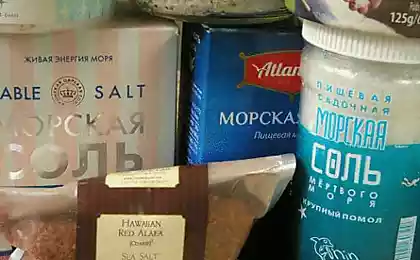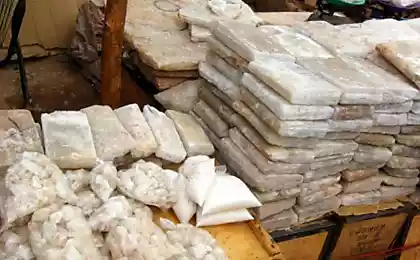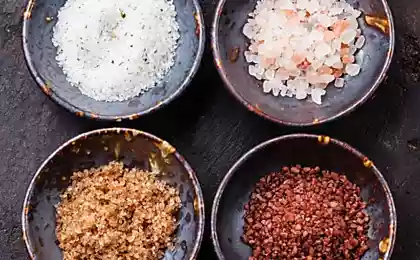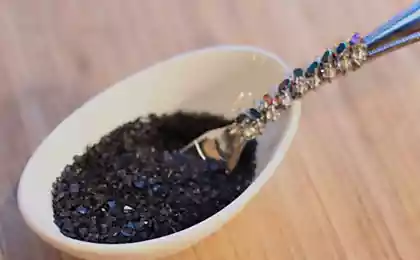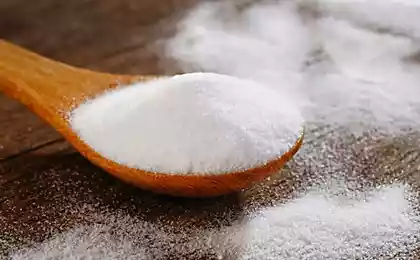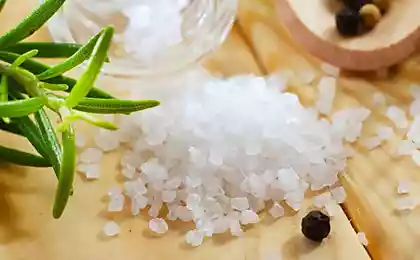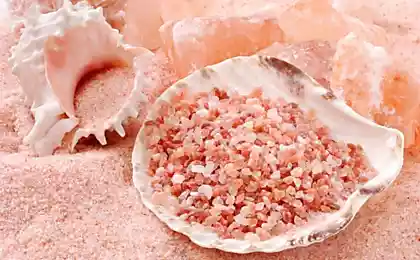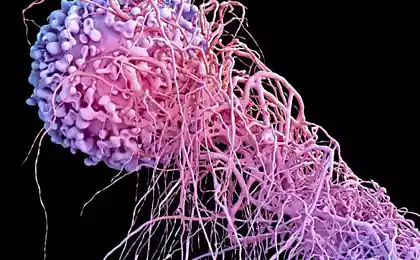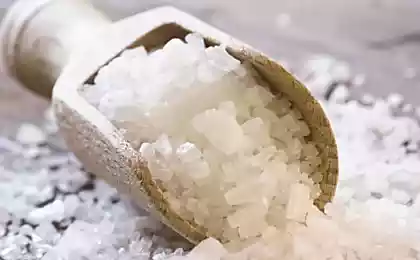671
Sea salt — the facts and myths
It is considered that the sea and ordinary, table salt is a different substance. The first is much more useful and more natural the second. Salt and truth is obtained from two different sources: underground mines and seawater. But this fact alone does not make them fundamentally different.
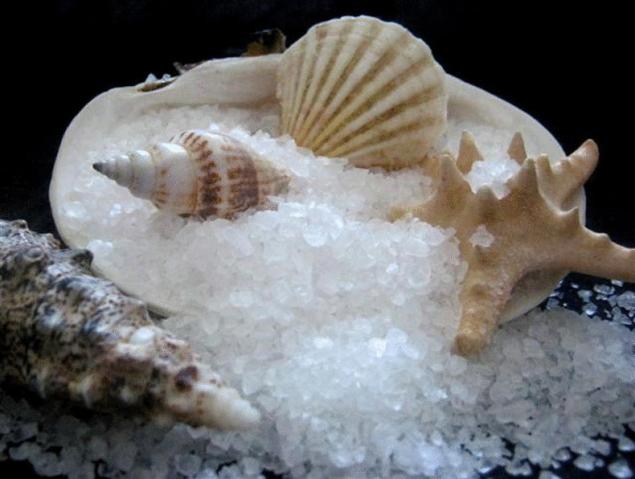
Underground deposits of salt left to us in inheritance from dried up ancient seas, disappeared at a particular stage in the history of our planet — from several million to hundreds of millions of years ago. Then, owing to geological processes, some salt deposits were closer to the surface of the earth, and they now exist in a kind of "domes". Other salt deposits are thousands of feet deeper, and therefore more difficult to extract.
Rock salt is ground with the big machines in cavities excavated in the thickness of the salt ranges. But rock salt is not suitable for human consumption, since drying of the ancient sea kept the silt and various organic residues.
Therefore salt is produced in a different way: pump water into the shaft to dissolve the salt, draining the salt water (saline solution) on the surface, to defend all the impurities, and finally evaporated using the vacuum now clean saline solution. The result is the familiar tiny crystals of table salt. In the coastal regions dominated by the Sunny weather, the salt can be obtained to allow the sun and wind evaporate water from small ponds, or "Islands" of sea water.
There are many types of sea salt extracted from the water spaces of the planet and purified in one way or another. Known, for example, grey and pinkish-grey sea salts from Korea and France, as well as black sea salt from India, the color of which is determined by the local varieties of clay and algae present in the evaporation ponds, not the salt (sodium chloride), which they are. Black and red sea salts from the Hawaiian Islands owe their color to small random splashes of black lava and red clay. These rare and exotic types of salt are sold in specialty stores and often used by enterprising chefs. Of course, they are undeniably unique taste, like a mixture of salts with different types of clay and algae. Each salt has its supporters.
MINERALS
If you evaporate all the water from the ocean (after removing the fish), it will remain sticky, grey and bitter mass of silt, 78% consisting of sodium chloride — common salt. The remaining 22% consist of 99% of compounds of magnesium and calcium, and are responsible for the bitterness. In addition, in very small quantities there are at least 75 chemical elements. This last fact is the basis for the widespread allegations of "mass nutrient minerals in sea salt.
However, chemical analysis will diminish our enthusiasm minerals, even in such a raw and unprocessed mud, are present in minor amounts. For example, you would need to eat two tablespoons of this mass to obtain the amount of iron that you get from a single grape.
Sea salt, entering the shops, contains only a tenth of minerals compared with untreated sludge. And here's why: in the production process of sea salt give the sun to evaporate water from the ponds, but in any case, not all — and this is an important clarification. The evaporation of water the rest is becoming more concentrated solution of sodium chloride. When the concentration of salt in the ponds exceeds its content in sea water is approximately nine times the salt begins to transform into crystals. Then the crystals are raked or scraped off for subsequent washing, drying and packing. (How can I wash the salt not dissolving it? It has been washed with a solution that already contains so much salt that it can no longer dissolve it. Scientists call it a saturated solution.) It is very important that this "natural" crystallization itself is an extremely effective cleaning process.
Evaporation and subsequent crystallization from the heat of the sun make the sodium chloride about 10 times purer — that is, free from other mineral substances, than he was in the ocean. Which aqueous solution would you take, if it is dominated by one chemical (in our case sodium chloride) along with many other minerals, albeit in much smaller quantities (in our case, of other mineral substances, salt) by evaporation of salt is the predominant substance will take the form of crystal, and all other components will remain in solution. This is the cleaning process that is always used in chemistry. For example, M. Sklodowska-Curie used it to separate pure radium from radium ore. Salt is obtained through solar evaporation of sea water, contains 99% pure sodium chloride, and additional processing is not required. The remaining 1% consists almost entirely of compounds of magnesium and calcium, and all those other 75 "valuable minerals" are virtually absent.
To get the amount of iron contained in a single grape, now I have to eat about 100 grams of this salt. In this context, the notion that sea salt already contains iodine originally, is a myth. Due to the fact that certain types of sea vegetation is rich in iodine, some people think the ocean is kind of "with iodinated broth." As for the chemical elements present in sea water, it in 100 times more boron than iodine, but I've never heard of advertising of sea salt as a source of boron.
SUPPLEMENTS
About sea salt is often written that there are no "additives with an unpleasant taste", as in table salt. However, whatever its origin, the salt in any case, contains additives against caking (e.g., calcium silicate) to the granule easily dropped off; the salt crystals, in fact, little cubes, and they tend to cling to each other. Due to the fact that calcium silicate (like all the other additives against caking) does not dissolve in water, and table salt when dissolved in water gives a solution of a whitish color. Among other additives against caking can be called magnesium carbonate (E504), calcium carbonate (E170) and calcium phosphates (E341). All of these chemicals are devoid of taste and smell. But even if they had the taste and smell and professional tasters could distinguish the subtle flavors in the solid salt, which arose with the introduction of these additives (less than 1%), still the dilution factor that occurs when you add salt according to any recipe, would not have allowed the tasters to achieve your goal.
It cannot be denied that some of the smaller varieties of sea salt (read: more expensive) have an interesting taste characteristics. But it depends on how they are used and what we mean by "taste". The taste of food has three components: taste, smell and texture. In the case of salt, we can eliminate the smell, because neither the sodium chloride nor sulphate of magnesium or calcium that may be present in some of the less purified grades of sea salt have no smell. However, our sense of smell is very sensitive, and perhaps thanks to him, we will feel the smell of these less purified types of salt. In addition, when the salt is inhale and it hits the nose in the form of fine dust, some people are able to feel a light metallic smell.
What actually feel the taste buds and what are the tactile sensation from the salt in your mouth? Depending on how the salt was collected and processed, the crystals of different brands of sea salt may differ in shape from flakes to pyramids and fragments of irregular shape (you can see this if you take a magnifying glass). The crystal size also varies from small to large, although they are larger than regular table salt. If this salt is to sprinkle regarding dry food, as, for example, a slice of tomato, larger and more scaly crystals can create small areas of salinity — when they touch the tongue and then dissolve or when they get teeth and get squashed.That's why chef is so appreciated sea salt just for these little bursts of salty flavor. Table salt can do that, because its compact small crystals dissolve on the tongue more slowly. Thus, it is a complex form of crystals, not their marine origin, determines the flavor characteristics of many types of sea salt. The reason most types of sea salt has large, irregular-shaped crystals, is the following: it is the result of the slow evaporation process, while the quick evaporation process in vacuum (i.e. at a pressure below atmospheric), which is used for the production of table salt, leaving tiny crystals of the correct form — those which are easily poured from a salt shaker with holes. This phenomenon is well familiar to chemists: the faster the crystal growth process, the smaller will be their size.
COOKING
The size and shape of the crystals does not matter, when the salt is used in cooking, because they dissolve and disappear in the liquid. And when they are dissolved, the difference in texture is insignificant. The taste of food is not affected by the shape of the crystals to dissolve. This is another reason why it makes no sense to specify in the prescription any special kind of sea salt, if in the process of cooking this dish will contain moisture. And what recipe doesn't?
A widespread belief that sea salt is saltier than table. But since both salts consist of 99% pure sodium chloride that's not true. This view arose from the fact that in one of your tests flake having an irregular shape crystals of sea salt dissolved on the tongue instantly, faster, bringing the sensation of salinity that distinguishes them from small and slowly dissolving crystals of table salt. But then again the ocean is neither here nor there, it's all in the form of crystals.
The idea that sea salt is saltier, has led to statements that when brining, you can use it in smaller amounts. Because sea salt generally consists of large crystals of complex shapes that are not very tight are in a teaspoon. In a teaspoon of sea salt will have less sodium chloride than the same spoon of table salt its small crystals. It turns out that when comparing same teaspoons with different content of sea salt is less salty than table salt. In comparison by weight, they are identical — because every gram of sodium chloride salt is the same as any other gram of the same substance. It is impossible to reduce the consumption of salt, eating the same amount of salt, but just in a different form.
From the book by Robert wolke, Marlene Parrish "what Einstein told his cook".
Source: /users/1077

Underground deposits of salt left to us in inheritance from dried up ancient seas, disappeared at a particular stage in the history of our planet — from several million to hundreds of millions of years ago. Then, owing to geological processes, some salt deposits were closer to the surface of the earth, and they now exist in a kind of "domes". Other salt deposits are thousands of feet deeper, and therefore more difficult to extract.
Rock salt is ground with the big machines in cavities excavated in the thickness of the salt ranges. But rock salt is not suitable for human consumption, since drying of the ancient sea kept the silt and various organic residues.
Therefore salt is produced in a different way: pump water into the shaft to dissolve the salt, draining the salt water (saline solution) on the surface, to defend all the impurities, and finally evaporated using the vacuum now clean saline solution. The result is the familiar tiny crystals of table salt. In the coastal regions dominated by the Sunny weather, the salt can be obtained to allow the sun and wind evaporate water from small ponds, or "Islands" of sea water.
There are many types of sea salt extracted from the water spaces of the planet and purified in one way or another. Known, for example, grey and pinkish-grey sea salts from Korea and France, as well as black sea salt from India, the color of which is determined by the local varieties of clay and algae present in the evaporation ponds, not the salt (sodium chloride), which they are. Black and red sea salts from the Hawaiian Islands owe their color to small random splashes of black lava and red clay. These rare and exotic types of salt are sold in specialty stores and often used by enterprising chefs. Of course, they are undeniably unique taste, like a mixture of salts with different types of clay and algae. Each salt has its supporters.
MINERALS
If you evaporate all the water from the ocean (after removing the fish), it will remain sticky, grey and bitter mass of silt, 78% consisting of sodium chloride — common salt. The remaining 22% consist of 99% of compounds of magnesium and calcium, and are responsible for the bitterness. In addition, in very small quantities there are at least 75 chemical elements. This last fact is the basis for the widespread allegations of "mass nutrient minerals in sea salt.
However, chemical analysis will diminish our enthusiasm minerals, even in such a raw and unprocessed mud, are present in minor amounts. For example, you would need to eat two tablespoons of this mass to obtain the amount of iron that you get from a single grape.
Sea salt, entering the shops, contains only a tenth of minerals compared with untreated sludge. And here's why: in the production process of sea salt give the sun to evaporate water from the ponds, but in any case, not all — and this is an important clarification. The evaporation of water the rest is becoming more concentrated solution of sodium chloride. When the concentration of salt in the ponds exceeds its content in sea water is approximately nine times the salt begins to transform into crystals. Then the crystals are raked or scraped off for subsequent washing, drying and packing. (How can I wash the salt not dissolving it? It has been washed with a solution that already contains so much salt that it can no longer dissolve it. Scientists call it a saturated solution.) It is very important that this "natural" crystallization itself is an extremely effective cleaning process.
Evaporation and subsequent crystallization from the heat of the sun make the sodium chloride about 10 times purer — that is, free from other mineral substances, than he was in the ocean. Which aqueous solution would you take, if it is dominated by one chemical (in our case sodium chloride) along with many other minerals, albeit in much smaller quantities (in our case, of other mineral substances, salt) by evaporation of salt is the predominant substance will take the form of crystal, and all other components will remain in solution. This is the cleaning process that is always used in chemistry. For example, M. Sklodowska-Curie used it to separate pure radium from radium ore. Salt is obtained through solar evaporation of sea water, contains 99% pure sodium chloride, and additional processing is not required. The remaining 1% consists almost entirely of compounds of magnesium and calcium, and all those other 75 "valuable minerals" are virtually absent.
To get the amount of iron contained in a single grape, now I have to eat about 100 grams of this salt. In this context, the notion that sea salt already contains iodine originally, is a myth. Due to the fact that certain types of sea vegetation is rich in iodine, some people think the ocean is kind of "with iodinated broth." As for the chemical elements present in sea water, it in 100 times more boron than iodine, but I've never heard of advertising of sea salt as a source of boron.
SUPPLEMENTS
About sea salt is often written that there are no "additives with an unpleasant taste", as in table salt. However, whatever its origin, the salt in any case, contains additives against caking (e.g., calcium silicate) to the granule easily dropped off; the salt crystals, in fact, little cubes, and they tend to cling to each other. Due to the fact that calcium silicate (like all the other additives against caking) does not dissolve in water, and table salt when dissolved in water gives a solution of a whitish color. Among other additives against caking can be called magnesium carbonate (E504), calcium carbonate (E170) and calcium phosphates (E341). All of these chemicals are devoid of taste and smell. But even if they had the taste and smell and professional tasters could distinguish the subtle flavors in the solid salt, which arose with the introduction of these additives (less than 1%), still the dilution factor that occurs when you add salt according to any recipe, would not have allowed the tasters to achieve your goal.
It cannot be denied that some of the smaller varieties of sea salt (read: more expensive) have an interesting taste characteristics. But it depends on how they are used and what we mean by "taste". The taste of food has three components: taste, smell and texture. In the case of salt, we can eliminate the smell, because neither the sodium chloride nor sulphate of magnesium or calcium that may be present in some of the less purified grades of sea salt have no smell. However, our sense of smell is very sensitive, and perhaps thanks to him, we will feel the smell of these less purified types of salt. In addition, when the salt is inhale and it hits the nose in the form of fine dust, some people are able to feel a light metallic smell.
What actually feel the taste buds and what are the tactile sensation from the salt in your mouth? Depending on how the salt was collected and processed, the crystals of different brands of sea salt may differ in shape from flakes to pyramids and fragments of irregular shape (you can see this if you take a magnifying glass). The crystal size also varies from small to large, although they are larger than regular table salt. If this salt is to sprinkle regarding dry food, as, for example, a slice of tomato, larger and more scaly crystals can create small areas of salinity — when they touch the tongue and then dissolve or when they get teeth and get squashed.That's why chef is so appreciated sea salt just for these little bursts of salty flavor. Table salt can do that, because its compact small crystals dissolve on the tongue more slowly. Thus, it is a complex form of crystals, not their marine origin, determines the flavor characteristics of many types of sea salt. The reason most types of sea salt has large, irregular-shaped crystals, is the following: it is the result of the slow evaporation process, while the quick evaporation process in vacuum (i.e. at a pressure below atmospheric), which is used for the production of table salt, leaving tiny crystals of the correct form — those which are easily poured from a salt shaker with holes. This phenomenon is well familiar to chemists: the faster the crystal growth process, the smaller will be their size.
COOKING
The size and shape of the crystals does not matter, when the salt is used in cooking, because they dissolve and disappear in the liquid. And when they are dissolved, the difference in texture is insignificant. The taste of food is not affected by the shape of the crystals to dissolve. This is another reason why it makes no sense to specify in the prescription any special kind of sea salt, if in the process of cooking this dish will contain moisture. And what recipe doesn't?
A widespread belief that sea salt is saltier than table. But since both salts consist of 99% pure sodium chloride that's not true. This view arose from the fact that in one of your tests flake having an irregular shape crystals of sea salt dissolved on the tongue instantly, faster, bringing the sensation of salinity that distinguishes them from small and slowly dissolving crystals of table salt. But then again the ocean is neither here nor there, it's all in the form of crystals.
The idea that sea salt is saltier, has led to statements that when brining, you can use it in smaller amounts. Because sea salt generally consists of large crystals of complex shapes that are not very tight are in a teaspoon. In a teaspoon of sea salt will have less sodium chloride than the same spoon of table salt its small crystals. It turns out that when comparing same teaspoons with different content of sea salt is less salty than table salt. In comparison by weight, they are identical — because every gram of sodium chloride salt is the same as any other gram of the same substance. It is impossible to reduce the consumption of salt, eating the same amount of salt, but just in a different form.
From the book by Robert wolke, Marlene Parrish "what Einstein told his cook".
Source: /users/1077
